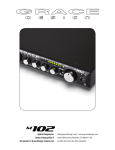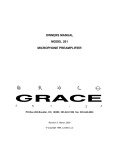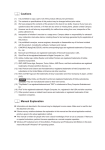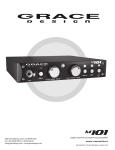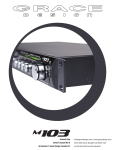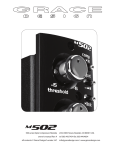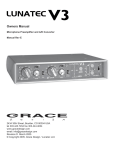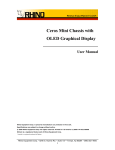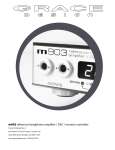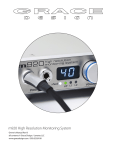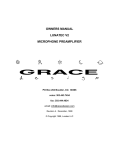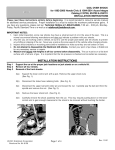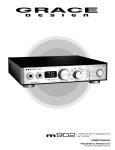Download m501 owners manual Rev A
Transcript
01 m5 2434 30th Street, Boulder, CO 80301 USA tel 303.443.7454 fax 303.444.4634 [email protected] / www.gracedesign.com 500 series microphone preamplifier module owner’s manual Rev A all contents © Grace Design/ Lunatec LLC Welcome and thanks for purchasing the Grace Design m501 microphone 500 series preamplifier and instrument DI. We design and build our products to be completely reliable and easy to use, so you can concentrate on making great recordings, not struggling with complicated equipment or difficult product manuals. While you will find the m501 is completely straightforward to use, we do ask that you spend a little time familiarizing yourself with this product manual to help avoid any difficulties. In the event that you do encounter any issues with this or any of our products, feel free to call us at 303-443-7454. Our office hours are 9 to 5, Monday through Friday, MST, or you may email any technical questions to: [email protected]. Also, please check out our web site (www.gracedesign.com) for the latest Grace Design product information, owners manuals and technical documents. Grace Design has been building audiophile-quality products for the recording industry over 15 years. The technology in the m501 is the result of extensive listening, field-testing and careful refinement. Your new m501 preamplifier represents a combination of absolutely pristine audio performance, robust mechanical construction and bombproof reliability at a reasonable price. Regardless of what audio sources you plan to record, your m501 will faithfully serve as an invisible link between your microphone or instrument and recording device. We sincerely hope our products help you achieve a new level of excellence in your work! The Grace Design Team Contents Important Safety Information GENERAL SAFETY MARKING SYMBOLS SERVICE INFORMATION FEATURES front panel FEATURES m501 connectiONS BASIC OPERATION Using the Trim control Using ribbon mic mode Using the HPF Cable Diagrams Basic Wiring Diagram card edge connector contact assignments specifications warranty information Manual Revisions 501 m page 2 3 3 3 3 4 4 5 6 6 6 6 7 7 7 8 9 10 Important Safety Information GENERAL •Indoor use only •Ordinary Protection: This equipment should not be exposed to dripping or splashing. •Avoid placing objects filled with liquids, such as vases or glasses, on this equipment. •Pollution Degree 2 •Maximum Relative Humidity: <80% •Operation temperature range: 10 °C to 40 °C •Storage and transportation temperature range –40 °C to 70 °C •Maximum altitude: 3000m (9843 ft) •Equipment suitable for continuous operation •Weight: preamplifier 0.31kg (.7lbs) SAFETY MARKING SYMBOLS CAUTION: READ ACCOMPANYING DOCUMENTS This symbol, located on the equipment and in this manual, refers to important instructions. Read this manual thoroughly before operating this equipment. WARNING: ELECTRICAL SHOCK HAZARD This symbol, located on the equipment and in this manual, indicates the potential for electrical shock hazard. SERVICE INFORMATION The Grace Design m501 contains no user serviceable components. Contact Grace Design for repair and upgrade information. In the event that your Grace Design m501 needs to be returned to the factory, contact us for a return authorization number. 501 m page 3 FEATURES • • • • • • • • • • • • • • • • • • Fast, musical transimpedance amplifier architecture Fully balanced, transformerless XLR microphone input High impedance 1/4 inch instrument DI input 12 position precision gold contact rotary switch gain control 0.5% precision metal film resistors in signal path High quality conductive plastic 10dB output trim control 75Hz 12dB/octave high pass filter Two color LED peak meter shows signal present and peak Ribbon mic mode (also great for dynamic mics)- Optimizes signal path for ribbon mics Aluminum 1/2 width 1U chassis / two units fit together in a standard 1U rack tray Sealed gold contact relays for signal switching High precision active balanced output circuit No electrolytic capacitors in the signal path Ultra clean 48 Volt phantom power Minimal internal signal wiring Robust RFI and EMI protection 5 year warranty on parts and labor Made in the USA front panel FEATURES m 50 1 PEAK INDICATOR The LED peak indicator, which monitors the signal at the output of the preamplifier, illuminates green at -14dBu and red at +16dB (10dB before clipping). GAIN CONTROL The gain control has 12 positions and adjusts the voltage gain on the microphone input from 10dB to 65dB in 5dB steps. When using the instrument input, the gain range is –10dB to 45dB in 5dB steps. 10dB GAIN 65dB 48V 48V PHANTOM POWER This switch provides 48 Volts to power condenser microphones. LED indicator illuminates red when active. ribbon RIBBON SWITCH HPF Pushing this switch activates ribbon mic mode which optimizes the signal path for non-active ribbon mics. LED indicator illuminates white when activated. HIGH PASS FILTER (labeled HPF) 75Hz, 12dB/Octave high pass filter. 0dB TRIM CONTROL TRIM The trim control provides zero to +10dB of continuously variable output trim. 1/4” TRS instrument HI-Z input For high-impedance instrument or line level inputs. HI-Z 501 m page 4 10dB m501 connections MICROPHONE INPUT The mic input is located on the back of your 500 series rack. This connector should be wired pin 2 positive, pin 3 negative and pin 1 ground (check with your rack manufacturer’s documentation for connector details). 48V phantom power, if used, is supplied on pins 2 and 3. BALANCED XLR OUTPUT Balanced XLR line output connector are located on the back of your 500 series rack. This connector should be wired pin 2 positive, pin 3 negative and pin 1 ground (check with your rack manufacturer’s documentation for connector details). INSTRUMENT AND LINE INPUT Instrument and line level signal connections are made using the ¼” TRS jack on the front panel of the m501 module. This connector is balanced with the tip positive, ring negative and sleeve ground. When a plug is inserted into the instrument input, a sealed gold contact relay switches the preamplifier input source from the rear panel mic input connector to the front panel TRS jack. The input impedance of the instrument input is 2.5M Ohm unbalanced and 5M Ohm balanced, which is ideal for inserting high impedance sources such as guitars with passive pickups, as well as any instrument with a high level output. Please note that the gain range of the preamplifier when using the instrument input is –10dB to +55dB. Using the instrument input with an unbalanced source is simple. When a mono ¼” jack is used, the sleeve will automatically ground the inverting input (ring) when plugged in. Installing the m501 in a 500 series rack 1. Open your m501 box. The module is in a bag under the plastic ‘korvu’ retaining sheet, which you should be careful not to cut. Simply fold down the outer cardboard flaps, then the under side flaps, which will loosen the module from under the plastic sheet. 2. Turn off and unplug your 500 series rack frame. Inspect the card slot you intend you use to make sure that it is clean and free of any debris. 3. Before removing your m501 from its anti-static bag, discharge any static electricity buildup you may have by touching your 500 series rack. 4. Pull your m501 module out of its anti-static bag and carefully slide it into place in the designated opening. Sight down the back of the module (use a flashlight if necessary) and ensure the card edge connector is aligned to seat into the card slot of the frame. 5. Firmly and evenly push the m501 module into place until its is positively seated in the card slot. 6. Use the 2 supplied #4-40 hex head screws and 3/32” hex wrench to mount the m501 front panel to the 500 series rack. These screws have a pretty tight fit; please be careful not to cross thread. 7. Plug your 500 series rack back into the AC source and power up your rack. Your m501 will automatically power up with your 500 series rack. 501 m page 5 OPERATING THE m501 BASIC OPERATION Turn the gain and trim controls fully counter-clockwise and check that the +48V phantom power is off. Connect the microphone to the preamplifier and then turn on the phantom power switch on if required. When sending a signal to a recorder that has fixed input levels, simply increase the gain until the optimum recording level is reached. When sending a signal to a recorder with a variable input, set the record level control on the recorder to 12 o’clock or midway between minimum and maximum, then set the gain on the m501 until the optimum recording level is reached. NOTE: It is important to observe proper microphone power sequencing when using phantom powered mics. Always make sure that the +48V phantom power is turned off and discharged before connecting or disconnecting a microphone. The red +48V LED indicates the presence of voltage at the microphone input connector. It will go out when the +48V supply is sufficiently discharged. Using the Trim control The trim control can be used for fine output level adjustment as well as for level riding during recording. It can also add an additional 10dB of gain for a total maximum preamplifier gain of 75dB. If the trim control is not needed for riding gain or providing extra gain, then it should be left at zero (fully counter clockwise). Using ribbon mic mode Pushing the ribbon switch does three things: +48V phantom power is locked-out to prevent potential damage to ribbon microphones, the impedance of the mic input is raised from 8.1k Ohms to 20k Ohms, and the 48V DC blocking input capacitors are bypassed with sealed gold contact relays. The maximum gain available on the m501 is 75dB, which is achieved by setting the gain control to 65dB and the trim to 10dB. For recording low level sources with ribbon microphones, the m501 has ample available gain, sufficient for even the most demanding low-level recording scenarios. Note that if the +48V phantom power is on and then the ribbon mode is engaged there will be a momentary delay before the m501 enters ribbon mode. This is because the m501 logic circuitry waits for the +48V at the mic input to discharge before enabling ribbon mode. Likewise, if you are in ribbon mode and the +48V switch is on, then phantom power will turn on immediately if the ribbon mode switch is released. In general it is best practice to turn off the +48V phantom power before entering ribbon mode. The ribbon mode on the m501 is also ideal for many dynamic mics. Using the HPF The high pass filter (HPF), sometimes referred to as a bass roll-off, starts at 75Hz. This 12dB/octave filter is optimized for minimum phase shift. The most common uses for this are in situations where low-end rumble from mechanical sources or wind are present, to reduce excessive proximity effect, or to simply help reign in excessive low end during recording. 501 m page 6 Cable Diagrams Use this cable when connecting the balanced XLR output to an unbalanced, 1/4” input. Balanced Output XLR Unbalanced 1/4” HOT 1 2 GROUND SHIELD 3 (OPEN) Basic Wiring Diagram The following is a basic overview of common wiring possibilities for the m501. All applications will vary, so please feel free to contact your dealer or us directly for setup and wiring information. GAIN 10dB 0dB TRIM HI-Z m 50 1 65dB 48V ribbon HPF 10dB m501 frontpanel PUSH PUSH PUSH PUSH PUSH PUSH IN IN IN IN IN IN OUT OUT OUT OUT OUT OUT microphone Instrument 500 series rack frame rearpanel Recorder / Converter / DAW Interface Mixer / PA system card edge connector contact assignments 1) Chassis Ground 2) Output + 3) NC 4) Output 5) Audio Ground 6) NC 7) NC 8) Input 9) NC 10) Input + 11) NC 12) +16VDC IN 13) Power Ground 14) -16VDC IN 15) +48VDC IN 501 m page 7 specifications GAIN RANGE (5dB steps) Mic input Hi-Z input Output trim control 10 - 65dB -10 - 45dB 0 to +10dB THD+N (1kHz, 22Hz-22kHz BW) @ 20dB Gain +20dBu out @ 40dB Gain +20dBu out @ 60dB Gain +20dBu out <0.00085% <0.0010% <0.0050% INTERMODULATION DISTORTION (@ 40dB Gain, +20dBu out) SMPTE/DIN 4:1 7kHz/50Hz <0.0020 NOISE - REFERRED TO INPUT 50Ω source 150Ω source 600Ω source <-130dB <-128dB <-124dB CMRR (@60dB Gain, 3.5Vcm) 100Hz 1kHz 10kHz >55dB >75dB >65dB PHASE DEVIATION (HPF off) 50Hz-25kHz @40dB Gain <10° FREQUENCY RESPONSE Mic input @ 40dB Gain -3dB Mic input @ 40dB Gain -0.5dB Hi-Z input @ 20dB Gain -3dB Hi-Z input @ 20dB Gain -0.5dB 3.8Hz-288kHz 8.35Hz-135kHz 1.7Hz-180kHz 4Hz-72kHz IMPEDANCE Mic input Mic input, Ribbon mode Hi-Z input (unbalanced) Hi-Z input (balanced) Balanced Output Unbalanced Output 8.1kΩ 20kΩ 2.5MΩ 5MΩ 300Ω 150Ω PEAK LED METER Green threshold Red threshold MAXIMUM OUTPUT LEVEL 100k Ohm load, 0.1% THD , 1kHz, API Lunchbox WEIGHT and DIMENSIONS 0.7 lb 316g POWER CONSUMPTION Current required from +16V and -16V power supplies 501 m page 8 -12dBu +16dBu 27dBu H5.25” x W1.5” x D6.6” H13.34cm x W3.81cm x D16.75cm 120mA Max warranty information Grace Design warrants all of our products to be free of defective parts and workmanship for a period of five years. This warranty period begins at the original date of purchase and is transferable to any person who may subsequently purchase the product during this time. This warranty excludes the following conditions: normal wear and tear, misuse, customer negligence, accidental damage, unauthorized repair or modification, cosmetic damage and damage incurred during shipment. During the time of this warranty, Grace Design will repair or replace, at its option, any defective parts or repair defective workmanship without charge, provided the customer has appropriate proof of purchase and that the product has its original factory serial number. In all warranty claims the customer is responsible for shipping costs to the Grace Design facility, and Grace Design pays for return ground shipping. In order for Grace Design to provide efficient and timely warranty service, it is important that you mail the completed warranty registration card enclosed with all of our products within 10 days of the original date of purchase. You may also register your product directly with Grace Design by telephone (303-443-7454 MondayFriday 9:00am to 5:00pm MST), or you can register your product online at www.gracedesign.com. This warranty is in lieu of all other warranties whether written, expressed, or implied, INCLUDING ANY WARRANTIES OF MERCHANTABILITY OR FITNESS FOR A PARTICULAR PURPOSE. In no event will Grace Design be liable for lost profits or any other incidental, consequential or Exemplary damages, even if Grace Design is aware of the possibility of such damages. In no event will Grace Design’s liability exceed the purchase price of the product. This warranty gives the customer specific legal rights. The customer may also have other rights, which vary from state to state. Some states do not allow limitations on implied warranties or consequential damages, so some of the limitations of the above may not apply to a particular customer. 501 m page 9 Manual Revisions 501 m Revision Page A all page 10 Change Date Initials 9/15/09 edg










